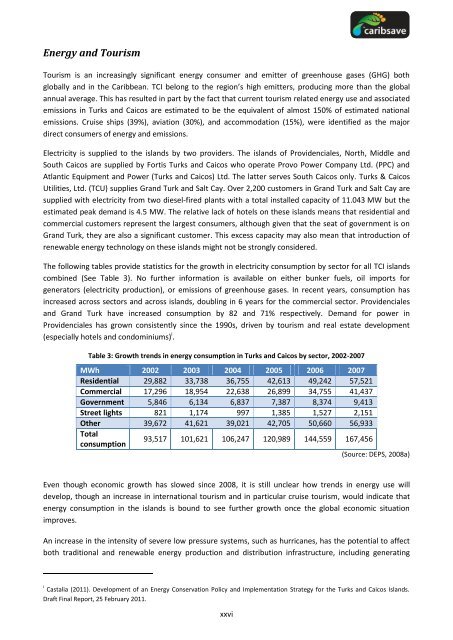You also want an ePaper? Increase the reach of your titles
YUMPU automatically turns print PDFs into web optimized ePapers that Google loves.
Energy <strong>and</strong> Tourism<br />
Tourism is an increasingly significant energy consumer <strong>and</strong> emitter of greenhouse gases (GHG) both<br />
globally <strong>and</strong> in the Caribbean. TCI belong to the region’s high emitters, producing more than the global<br />
annual average. This has resulted in part by the fact that current tourism related energy use <strong>and</strong> associated<br />
emissions in <strong>Turks</strong> <strong>and</strong> <strong>Caicos</strong> are estimated to be the equivalent of almost 150% of estimated national<br />
emissions. Cruise ships (39%), aviation (30%), <strong>and</strong> accommodation (15%), were identified as the major<br />
direct consumers of energy <strong>and</strong> emissions.<br />
Electricity is supplied to the isl<strong>and</strong>s by two providers. The isl<strong>and</strong>s of Providenciales, North, Middle <strong>and</strong><br />
South <strong>Caicos</strong> are supplied by Fortis <strong>Turks</strong> <strong>and</strong> <strong>Caicos</strong> who operate Provo Power Company Ltd. (PPC) <strong>and</strong><br />
Atlantic Equipment <strong>and</strong> Power (<strong>Turks</strong> <strong>and</strong> <strong>Caicos</strong>) Ltd. The latter serves South <strong>Caicos</strong> only. <strong>Turks</strong> & <strong>Caicos</strong><br />
Utilities, Ltd. (TCU) supplies Gr<strong>and</strong> Turk <strong>and</strong> Salt Cay. Over 2,200 customers in Gr<strong>and</strong> Turk <strong>and</strong> Salt Cay are<br />
supplied with electricity from two diesel-fired plants with a total installed capacity of 11.043 MW but the<br />
estimated peak dem<strong>and</strong> is 4.5 MW. The relative lack of hotels on these isl<strong>and</strong>s means that residential <strong>and</strong><br />
commercial customers represent the largest consumers, although given that the seat of government is on<br />
Gr<strong>and</strong> Turk, they are also a significant customer. This excess capacity may also mean that introduction of<br />
renewable energy technology on these isl<strong>and</strong>s might not be strongly considered.<br />
The following tables provide statistics for the growth in electricity consumption by sector for all TCI isl<strong>and</strong>s<br />
combined (See Table 3). No further information is available on either bunker fuels, oil imports for<br />
generators (electricity production), or emissions of greenhouse gases. In recent years, consumption has<br />
increased across sectors <strong>and</strong> across isl<strong>and</strong>s, doubling in 6 years for the commercial sector. Providenciales<br />
<strong>and</strong> Gr<strong>and</strong> Turk have increased consumption by 82 <strong>and</strong> 71% respectively. Dem<strong>and</strong> for power in<br />
Providenciales has grown consistently since the 1990s, driven by tourism <strong>and</strong> real estate development<br />
(especially hotels <strong>and</strong> condominiums) i .<br />
Table 3: Growth trends in energy consumption in <strong>Turks</strong> <strong>and</strong> <strong>Caicos</strong> by sector, 2002-2007<br />
MWh 2002 2003 2004 2005 2006 2007<br />
Residential 29,882 33,738 36,755 42,613 49,242 57,521<br />
Commercial 17,296 18,954 22,638 26,899 34,755 41,437<br />
Government 5,846 6,134 6,837 7,387 8,374 9,413<br />
Street lights 821 1,174 997 1,385 1,527 2,151<br />
Other 39,672 41,621 39,021 42,705 50,660 56,933<br />
Total<br />
consumption<br />
93,517 101,621 106,247 120,989 144,559 167,456<br />
(Source: DEPS, 2008a)<br />
Even though economic growth has slowed since 2008, it is still unclear how trends in energy use will<br />
develop, though an increase in international tourism <strong>and</strong> in particular cruise tourism, would indicate that<br />
energy consumption in the isl<strong>and</strong>s is bound to see further growth once the global economic situation<br />
improves.<br />
An increase in the intensity of severe low pressure systems, such as hurricanes, has the potential to affect<br />
both traditional <strong>and</strong> renewable energy production <strong>and</strong> distribution infrastructure, including generating<br />
i Castalia (2011). Development of an Energy Conservation Policy <strong>and</strong> Implementation Strategy for the <strong>Turks</strong> <strong>and</strong> <strong>Caicos</strong> Isl<strong>and</strong>s.<br />
Draft Final Report, 25 February 2011.<br />
xxvi





